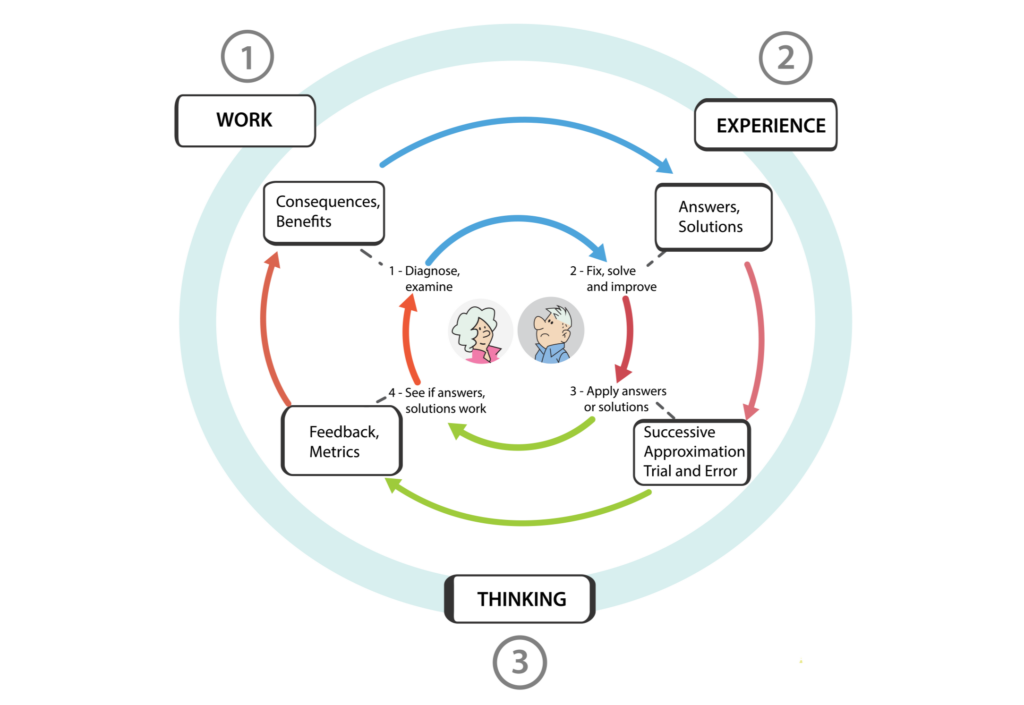The workplace is rapidly changing. With inevitable unprecedented challenges that may come, how do we keep our workers and leaders engaged, motivated, and productive? How can they emerge stronger when faced with a crisis?
In the Workflow Learning Model, we provide a practical and functional way to enable employees to learn new skills in the middle of a difficult situation. The emergence of an issue or concern in the workplace is already a “crisis” that needs to be addressed directly and practically.
However gloomy this sounds, take heart. These situations provide a learning opportunity for the worker to engage in solution-seeking and gain new skills in the process. These new skills are built through addressing the issue or problem at hand, oftentimes requiring new and innovative approaches to problems.
These new skills are built through addressing the issue or problem at hand, oftentimes requiring new and innovative approaches to problems.
| |
Ability to fix, solve, and improve | ||
| |
Ability to stay focused at work | ||
| |
Ability to quickly detect and anticipate critical situations | ||
| |
Ability to deal with the unknown |
Now, what if we could foster this progressive culture that leads to breakthroughs in learning? What would we need to do to enable employees to develop a culture for learning for results? What shift would be imperative for management to support and develop this culture?
In the article, How to Help Employees Learn New Skills Amid a Crisis, authors Kelly Palmer and Aaron Hurst outline ways to help employees learn new skills amidst a crisis. They suggest:
| |
End command and control. Let employees have the freedom to choose what and when to learn. | ||
| |
Teaching employees how to learn. Listen to what your employees are telling you about how they prefer to learn. Use a spaced, blended approach that provides opportunities for reflection and critical thinking. | ||
| |
Schedule a time for reflection through peer coaching. When peers trust each other, it opens the door for them to get together and discuss their goals and future and help each other develop plans to realize those goals. See more ideas on conversations and reflections. |
Coincidentally, these above suggestions align with the Workflow Learning Model and provide a roadmap to engage workers to learn how to get results on the job. This has direct benefits to the organization, management, and the worker. This way of learning differs from a top-down skill gap learning program identified and directed by management.
The Workflow Learning Model shows us the Workflow Diagnostic Process. This is the process that workers (and all of us) go through when we decide to fix, solve, or improve a situation. For most of us this process is intuitive; we don’t think through each step consciously. As you can see from the process map below, we start with diagnosing and examining the situation (1). As we follow the two inner circles of the diagram, we next seek answers (2), apply those answers (3) and check to see if those answers work.

The Workflow Diagnostic Process is an iterative process, rather than a straight linear process. We often loop back to early steps in a sort of “trial-and-error” approach. Understanding this model helps us think critically when faced with crisis. It provides a framework for understanding the natural flow of thinking and acting. Knowing this, we can find intersection points to support learning in the flow of work. Additionally, adding the suggestions of Kelly Palmer and Aaron Hurst enhances the overall effectiveness of learning and empowers the individuals in the organization to find creative solutions, even amidst a crisis.
In Summary
No one can accurately predict a big storm of disruption – it just happens. What organizations can do is recognize that crisis is inevitable and be ready to handle them as they occur. Leaders and workers play important roles in making sure the problems do not get out of hand. Using the Workflow Learning Model brings out opportunities and drives results. Through this we can keep track of where we are going, and how our workplace challenges may be resolved.
References:
Palmer, Kelly and Hurst, Aaron (2020), How to help employees learn new skills amid a crisis
Tip #176 – Build a Culture of Critical Thinking for Learning Breakthroughs
Tip #222 – How to Shift the Learning Culture From Dependency to Workflow Learning
Tip #242: 7 Strategic Rules for Transforming Classroom Training Into Effective Remote Training
Tip #243: How Do You Really Know if Your Participants Are Learning in Your Remote Training Sessions?
Ray Jimenez, PhD
Vignettes Learning
“Helping Learners Learn Their Way”

